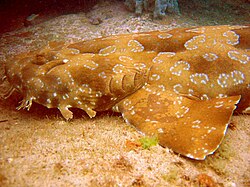Wobbegong: Difference between revisions
Robthepiper (talk | contribs) Undid revision 577536619 by 203.72.177.253 (talk) |
No edit summary |
||
| Line 1: | Line 1: | ||
{{Taxobox |
{{Taxobox |
||
| name = |
| name = booby |
||
| image = Wobbegong.jpg |
| image = Wobbegong.jpg |
||
| image_width = 250px |
| image_width = 250px |
||
Revision as of 18:25, 10 March 2014
| booby Temporal range:
| |
|---|---|

| |
| Spotted wobbegong, Orectolobus maculatus, showing the camouflage pattern and skin flaps typical of wobbegongs. | |
| Scientific classification | |
| Kingdom: | |
| Phylum: | |
| Class: | |
| Subclass: | |
| Order: | |
| Family: | Orectolobidae T. N. Gill, 1896
|
| Genera | |
Wobbegong is the common name given to the 12 species of carpet sharks in the family Orectolobidae. They are found in shallow temperate and tropical waters of the western Pacific Ocean and eastern Indian Ocean, chiefly around Australia and Indonesia, although one species (the Japanese wobbegong, Orectolobus japonicus) occurs as far north as Japan. The word wobbegong is believed to come from an Australian Aboriginal language, meaning "shaggy beard", referring to the growths around the mouth of the shark of the western Pacific.
Description
Wobbegongs are bottom-dwelling sharks and spend much of their time resting on the sea floor. Most species have a maximum length of 1.25 metres (4.1 ft) or less, but the largest, the spotted wobbegong, Orectolobus maculatus, and banded wobbegong, O. halei, reach about 3 metres (9.8 ft) in length.
Wobbegongs are well camouflaged with a symmetrical pattern of bold markings which resembles a carpet. Because of this striking pattern, wobbegongs and their close relatives are often referred to as carpet sharks. The camouflage is improved by the presence of small weedlike whisker lobes[1] surrounding the wobbegong's jaw, which help to camouflage it and act as sensory barbs. Wobbegongs make use of their relative invisibility to hide among rocks and catch smaller fish which swim too close, typical of ambush predators.
Wobbegongs are generally not dangerous to humans unless they are provoked. They have bitten people who accidentally step on them in shallow water; they may also bite scuba divers or snorkellers who poke or touch them, or who block their escape route[citation needed]. Wobbegongs are very flexible and can easily bite a hand that is holding on to their tail.[2]
They have many small but sharp teeth and their bite can be severe, even through a wetsuit; having once bitten, they have been known to hang on and can be very difficult to remove.[3]
Interaction with humans
Although wobbegongs do not eat humans, humans frequently eat wobbegongs; the flesh of a wobbegong or other shark is called flake and it is often used in fish and chips in Australia.
Wobbegong skin is also used to make leather.
Captivity
Although most wobbegong species are unsuitable for home aquaria due to their large adult size, this has not stopped some of these larger species from being commonly sold in the aquarium trade.[4] However some aquarists have had success in keeping smaller species, such as the tasselled wobbegong and Ward's wobbegong.[4] Small wobbegong species are "ideal" sharks for home aquarists to keep because they are the appropriate size and are sufficiently lethargic in lifestyle, enabling them to be accommodated within the limited space of home aquaria.[4] Some aquarists, by contrast, see the lack of activity to be a drawback to keeping wobbegongs and prefer more active sharks.[4] Wobbegongs are largely nocturnal and will consume tankmates, even rather large ones.[4] Due to their low metabolisms, wobbegong species are not fed as often as other sharks and most do well on two feedings weekly. Underfed wobbegongs can be recognized by visibly atrophied dorsal musculature.[4]
Genera and species
There are twelve living species of wobbegong, in three genera:[5]
Family Orectolobidae
- Genus Eucrossorhinus Regan, 1908
- Eucrossorhinus dasypogon (Bleeker, 1867) (Tasselled wobbegong)
- Genus Orectolobus Bonaparte, 1834
- Orectolobus floridus Last & Chidlow, 2008 (Floral banded wobbegong)
- Orectolobus halei Whitley, 1940.[6] (Gulf wobbegong or banded wobbegong)
- Orectolobus hutchinsi Last, Chidlow & Compagno, 2006.[7] (Western wobbegong)
- Orectolobus japonicus Regan, 1906 (Japanese wobbegong)
- Orectolobus leptolineatus Last, Pogonoski & W. T. White, 2010 (Indonesian wobbegong)
- Orectolobus maculatus (Bonnaterre, 1788) (Spotted wobbegong)
- Orectolobus ornatus (De Vis, 1883) (Ornate wobbegong)
- Orectolobus parvimaculatus Last & Chidlow, 2008 (Dwarf spotted wobbegong)
- Orectolobus reticulatus Last, Pogonoski & W. T. White, 2008 (Network wobbegong)
- Orectolobus wardi Whitley, 1939 (Northern wobbegong)
- Genus Sutorectus Whitley, 1939
- Sutorectus tentaculatus (W. K. H. Peters, 1864) (Cobbler wobbegong)
Fossil genera include:
- Eometlaouia Noubhani & Cappetta, 2002
See also
References
- ^ "Wobbegongs - five species encountered in Queensland". Queensland Primary Industries and Fisheries. 2009-03-02. Retrieved 2009-06-14.
- ^ Kuiter, Rudie (1999). Guide to Sea Fishes of Australia (amended ed.). New Holland Publishers (Aust.) Pty Ltd. p. 12. ISBN 1-86436-091-7.
- ^ "Shark sinks its teeth in for the long haul". The Sydney Morning Herald. 2004-02-12. Retrieved 2006-06-14.
- ^ a b c d e f Michael, Scott W. (March 2004). "Sharks at Home". Aquarium Fish Magazine. pp. 20–29.
- ^ Froese, Rainer; Pauly, Daniel (eds.). "Family Orectolobidae". FishBase. January 2009 version.
- ^ Huveneers (2006). "Redescription of two species of wobbegongs (Chondrichthyes: Orectolobidae) with elevation of Orectolobus halei Whitley 1940 to species level" (PDF). Zootaxa. 1284: 29–51.
- ^ Last, Chidlow & Compagno (2006). "A new wobbegong shark, Orectolobus hutchinsi n. sp. (Orectolobiformes: Orectolobidae) from southwestern Australia" (PDF). Zootaxa. 1239: 35–48.
